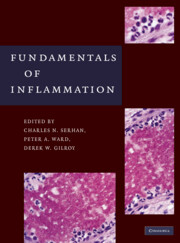Book contents
- Frontmatter
- Contents
- Contributors
- Preface
- PART I THE INFLAMMATORY RESPONSE – AN OVERVIEW
- PART II INDIVIDUAL CELL TYPES
- 4A Neutrophils I
- 4B Neutrophils II
- 5 Mast Cells as Sentinels of Inflammation
- 6 Basophils
- 7 Eosinophils
- 8 Macrophages
- 9 Lymphocytes
- 10 Fibroblasts and Stromal Cells
- 11 Neutrophil–Endothelial Cell Interactions
- PART III CHEMICAL MEDIATORS
- PART IV IMMUNOPHARMACOLOGY
- PART V INFLAMMATORY DISEASES/HISTOLOGY
- PART VI ANIMAL MODELS OF INFLAMMATION
- Index
- References
10 - Fibroblasts and Stromal Cells
from PART II - INDIVIDUAL CELL TYPES
Published online by Cambridge University Press: 05 April 2014
- Frontmatter
- Contents
- Contributors
- Preface
- PART I THE INFLAMMATORY RESPONSE – AN OVERVIEW
- PART II INDIVIDUAL CELL TYPES
- 4A Neutrophils I
- 4B Neutrophils II
- 5 Mast Cells as Sentinels of Inflammation
- 6 Basophils
- 7 Eosinophils
- 8 Macrophages
- 9 Lymphocytes
- 10 Fibroblasts and Stromal Cells
- 11 Neutrophil–Endothelial Cell Interactions
- PART III CHEMICAL MEDIATORS
- PART IV IMMUNOPHARMACOLOGY
- PART V INFLAMMATORY DISEASES/HISTOLOGY
- PART VI ANIMAL MODELS OF INFLAMMATION
- Index
- References
Summary
WHAT IS A STROMAL CELL?
The architecture of organs and tissues is closely adapted to their function to provide microenvironments in which specialized functions may be carried out efficiently. The nature and character of such microenvironments are primarily defined by the stromal cells that reside within the tissues. The most abundant cell types of the stroma are fibroblasts, which are responsible for the synthesis and remodeling of extracellular matrix (ECM) components. In addition, their ability to produce and respond to growth factors and cytokines allows reciprocal interactions with adjacent epithelial and endothelial structures and with infiltrating leukocytes. As a consequence, fibroblasts play a critical role during tissue development and homeostasis and have often been described as having a “landscaping” function. In this chapter, we concentrate on fibroblasts as the prototype stromal cell. However, the stroma also consists of blood and lymphatic vessels, and a wider definition of stromal cells might include endothelial cells, specialized cells such as pericytes (blood vessel supporting cells), and even tissue resident macrophages.
Stromal Cell Identity and Microenvironments
Tissue resident macrophages in the liver (Kupffer cells) and lung (alveolar macrophages) perform very different functions compared to macrophages in the brain (glial cells) or skin (Langerhans cells), yet they are all members of the monocyte/macrophage family. Until recently, fibroblasts had been thought of as ubiquitous, generic cells with a common phenotype even within different tissues.
- Type
- Chapter
- Information
- Fundamentals of Inflammation , pp. 126 - 140Publisher: Cambridge University PressPrint publication year: 2010
References
- 2
- Cited by



